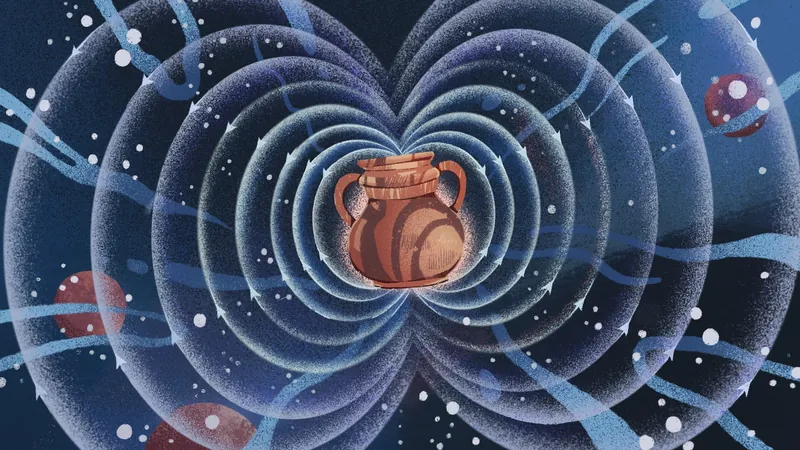
Unveiling Earth's Magnetic Mysteries: How Ancient Artifacts Hold Secrets to Our Planet's Future
2025-07-18
Author: Siti
Uncovering the Magnetic Anomaly of the Iron Age
In a groundbreaking discovery, archaeologist Erez Ben-Yosef stumbled upon an intriguing piece of Iron Age refuse in 2008, revealing the most significant magnetic-field anomaly ever recorded. While excavating in southern Jordan alongside geologist Ron Shaar, they analyzed copper slag, a byproduct of metal forging, which surprisingly documented a colossal surge in Earth’s magnetic field around 3,000 years ago.
Skepticism Meets Validation
Initially, the scientific community doubted the magnitude of this anomaly due to its unprecedented nature in geological history. However, after a decade of meticulous sampling and analysis of the region, the Levantine Iron Age Anomaly (LIAA) was established—confirming that the magnetic field in the Middle East oscillated dramatically from 1100 to 550 B.C.
Archaeomagnetism: Peering into Earth's Past
Utilizing a relatively new technique called archaeomagnetism, Ben-Yosef and Shaar delved into magnetic particles embedded in archaeological materials, allowing them to reconstruct ancient magnetic fields. This innovative method offers a more granular look at Earth’s magnetic history, especially for more recent periods, as opposed to traditional methods which often draw from infrequent rock formations.
Understanding the Geodynamo: Earth's Protective Shield
The geomagnetic field, generated by liquid iron's movement in Earth’s outer core, plays a crucial role in shielding us from dangerous space radiation. With evidence suggesting a gradual weakening of this vital magnetic field, experts emphasize the importance of studying past behaviors to predict future shifts. The only consistent observational data began in 1832, highlighting the challenges in comprehending the field’s dynamics.
Ancient Heating, Modern Discoveries
Archaeomagnetism taps into how our ancestors interacted with fire and heat materials. When heated, particles within materials align with Earth’s magnetic field, creating a fixed record of the field's direction once they cool. This technique affords insights into the magnetic landscape of the past, spanning a radius of approximately 310 miles (500 kilometers) around the sample.
The Global Quest for Magnetic Data
Despite its origins in the 1950s, archaeomagnetism is evolving with advancements in technology. However, its widespread application faces hurdles, including the high costs of magnetometers and the geographical bias of data collection, predominantly skewed towards Europe. With vast regions like Africa lacking adequate sampling tools, our understanding of global magnetic fluctuations remains limited.
Unraveling Mysterious Anomalies
Studying historic anomalies like the South Atlantic Anomaly (SAA) and LIAA reveals vital insights into the changes of the geomagnetic field over millions of years. The SAA, known for its weakened magnetic strength disrupting satellite communications, first emerged 11 million years ago, illustrating how ancient anomalies hold clues to our present-day challenges.
Future Implications for Technology and Safety
As the number of satellites increases—expected to soar to over 54,000 by 2030—the importance of understanding magnetic field behavior is paramount. We rely on Earth’s magnetic shield to protect satellites from hazardous radiation, especially in areas of diminished strength like the SAA.
Researching New Frontiers in Archaeomagnetism
Efforts to expand archaeomagnetic data are underway globally. The Institute for Rock Magnetism in the U.S. is working to build a more comprehensive history of the Midwest's magnetic field, drawing parallels to the achievements in the Levant. As projects around the world gain momentum, the potential to uncover unknown anomalies remains significant.
The journey into the past is more than an academic pursuit; it's critical for our understanding of the magnetic forces that shape our planet—and our future.

 Brasil (PT)
Brasil (PT)
 Canada (EN)
Canada (EN)
 Chile (ES)
Chile (ES)
 Česko (CS)
Česko (CS)
 대한민국 (KO)
대한민국 (KO)
 España (ES)
España (ES)
 France (FR)
France (FR)
 Hong Kong (EN)
Hong Kong (EN)
 Italia (IT)
Italia (IT)
 日本 (JA)
日本 (JA)
 Magyarország (HU)
Magyarország (HU)
 Norge (NO)
Norge (NO)
 Polska (PL)
Polska (PL)
 Schweiz (DE)
Schweiz (DE)
 Singapore (EN)
Singapore (EN)
 Sverige (SV)
Sverige (SV)
 Suomi (FI)
Suomi (FI)
 Türkiye (TR)
Türkiye (TR)
 الإمارات العربية المتحدة (AR)
الإمارات العربية المتحدة (AR)